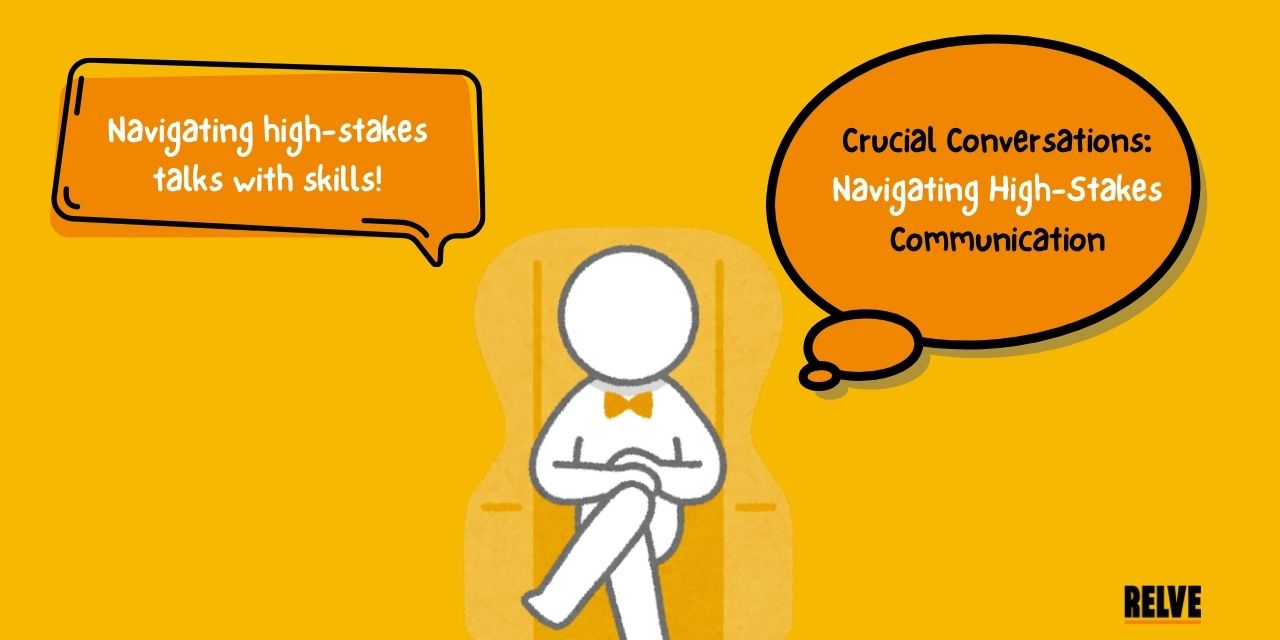Have you ever been stuck in a conversation where the tension was so thick you could cut it with a knife? It could be a discussion with your manager about a raise, confronting a team member who misses deadlines or addressing a personal issue with a dear one. These crucial conversations are moments when emotions are high, opinions differ, and stakes are significant.
Sometimes, people avoid such conversations or handle them poorly, which leads to misunderstandings, ruined relationships, or missed opportunities. The question is, how can we navigate these high-stakes interactions effectively? The key is understanding the crucial conversation framework and mastering the right skills to turn such difficulties into opportunities for growth and understanding.
At the heart of almost all chronic problems in our organizations, our teams, and our relationships lie crucial conversations—ones that we’re either not holding or not holding well.
Kerry Patterson and his co-authors explain in Crucial Conversations
So, how can we navigate these high-stakes interactions effectively? The key lies in understanding the crucial conversations framework and mastering the right skills to turn difficult discussions into opportunities for understanding and growth.
What is a Crucial Conversation?
Before diving into strategies, let’s define what is a crucial conversation.
A crucial conversation is any discussion where:
- Opinions differ – Two or more people have contrasting viewpoints.
- Emotions run high – People feel strongly about the topic.
- Stakes are significant – The outcome of the conversation has meaningful consequences.
These conversations can arise in the workplace, relationships, negotiations, or any situation where important decisions need to be made under pressure.
Crucial Conversations Start with Heart: Setting the Right Intentions
Before diving into strategies, let’s define what is a crucial conversation.
A crucial conversation is any discussion where:
- Opinions differ – Two or more people have contrasting viewpoints.
- Emotions run high – People feel strongly about the topic.
- Stakes are significant – The outcome of the conversation has meaningful consequences.
These conversations can arise in the workplace, relationships, negotiations, or any situation where important decisions need to be made under pressure.
How to Have Crucial Conversations Without Losing Control
When faced with a challenging conversation, many people either avoid the topic or react emotionally. However, adopting the crucial conversations model helps in navigating the discussion with clarity.
The Crucial Conversations Model: Four Key Steps
- Observe – Pay attention to verbal and non-verbal cues.
- Identify – Recognize when a conversation becomes crucial.
- Manage Emotions – Stay in control and avoid emotional hijacking.
- Encourage Dialogue – Foster an open and honest discussion.
The beauty of empathy is that it doesn’t demand that you agree with the other person’s ideas, but rather that you recognize their perspective.
Chris Voss, former FBI negotiator and author of Never Split the Difference
Crucial Conversations Training: A Must-Have for Leaders
Effective communication is a vital skill, especially for leaders and managers. Crucial conversations training for managers equips them with the necessary tools to address conflicts, set expectations, and inspire their teams.
Key Skills Taught in Crucial Conversations Training:
- Active listening – Truly hearing what the other person is saying without formulating a rebuttal.
- Staying composed under stress – Managing emotions even when the conversation gets heated.
- Finding common ground – Encouraging collaboration instead of confrontation.
According to Difficult Conversations: How to Discuss What Matters Most,
In a difficult conversation, it’s not the disagreement itself that causes trouble, but how we handle it.
Difficult Conversations: How to Discuss What Matters Most
Decide How to Decide: Crucial Conversations for Decision-Making
Sometimes, the most challenging part of a crucial conversation is reaching an agreement. This is where the principle of deciding how to decide crucial conversations comes into play.
Different Decision-Making Approaches:
- Command – One person makes the decision (e.g., a manager assigning tasks).
- Consult – Gathering input from others before making a final decision.
- Consensus – Everyone agrees on the decision collectively.
- Vote – Using majority rule when consensus isn’t possible.
By clearly defining how decisions will be made before diving into the details, conversations become more focused and productive.
Crucial Conversations for Accountability: Addressing Performance Issues
Holding people accountable can be uncomfortable, but avoiding the conversation only makes matters worse. Crucial conversations for accountability help create a culture where expectations are clear and issues are addressed promptly.
Observations, feelings, needs, and requests form the foundation of accountability conversations.
Marshall B. Rosenberg, in Nonviolent Communication
How to Have an Accountability Conversation:
- Describe the gap – Clearly explain the difference between expected and actual behavior.
- Ask for perspective – Allow the other person to share their thoughts.
- Collaborate on solutions – Work together to create an improvement plan.
- Follow up – Ensure continuous progress and reinforcement.
Crucial Conversations Style Under Stress: Keeping Your Cool
High-pressure situations often trigger crucial conversations under stress, where emotions can easily take over. To avoid escalation:
- Pause before responding – Give yourself time to think.
- Breathe deeply – Control physiological responses to stress.
- Use neutral language – Avoid blaming or accusatory statements.
- Reframe the situation – Look at the issue from a broader perspective.
We are often poor judges of other people’s intentions, especially under stress.
Malcolm Gladwell highlights in Talking to Strangers
Mastering the Art of Crucial Conversations
Mastering how to have crucial conversations is a lifelong skill that enhances both professional and personal relationships. By applying the principles from the crucial conversation’s framework, anyone can transform difficult discussions into opportunities for connection and resolution.
So, are you ready to apply these crucial conversation tools when stakes are high? The next time you find yourself in a tense discussion, remember: the right words, delivered the right way, can change everything.





